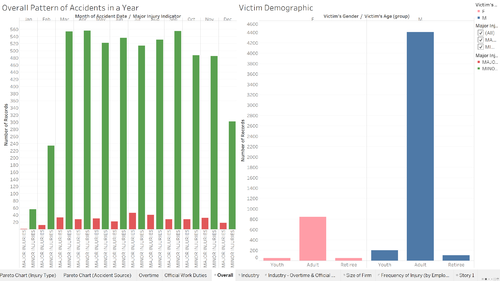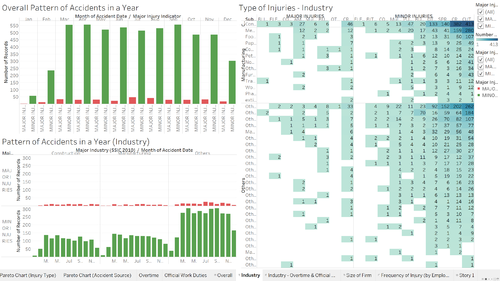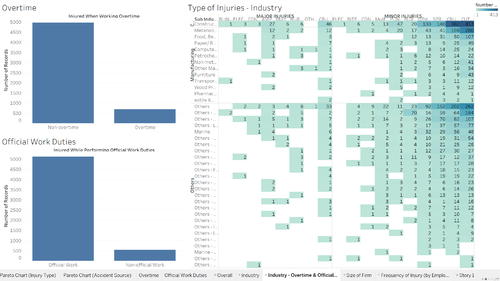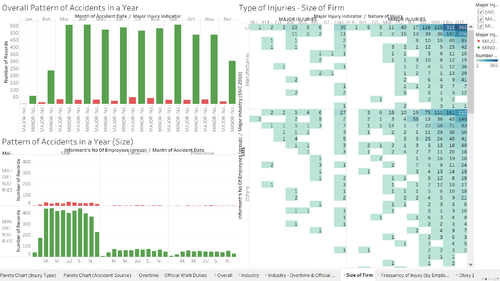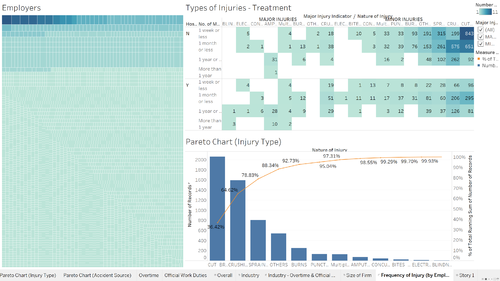IS428 2016-17 Term1 Assign2 Cornelia Tisandinia Larasati
Abstract
The Work Injury Compensation Act (WICA), administered by the Ministry of Manpower, provides injured employees with a low-cost and expeditious alternative to common law to settle compensation claims. However, with a broad spectrum of occupations in Singapore, certain job scopes will have a higher risk of injury than others. Hence, there is a need to analyse the frequency and types of injuries across industries and firm sizes, to determine the distribution of WICA spending in Singapore's workforce. Furthermore, there is a need to continually stay updated on the frequency of injuries in certain industries, as we will see later, to ensure that workplace safety standards are maintained across all industries.
The interactive dashboard visualisation can be found here.
Problem and Motivation
The Work Injury Compensation Act (WICA), administered by the Ministry of Manpower, provides injured employees with a low-cost and expeditious alternative to common law to settle compensation claims. To claim under WICA, the employee only needs to prove that he was injured in a work accident or suffered a disease due to his work. The three different types of compensation are:
- medical leave wages
- medical expenses
- lump sum compensation for permanent incapacity or death
While there are different multiplying factors for different ages and percentage of permanent incapacity[1], WICA currently does not have different tiers of payment for different injuries. With a broad spectrum of occupations in Singapore, certain job scopes will have a higher risk of injury than others.
Furthermore, there is a need to continually stay updated on the frequency of injuries in certain industries, as we will see later, to ensure that workplace safety standards are maintained across all industries.
The findings from this analysis could identify industries or specific companies lacking in workplace safety standards. Furthermore, it could also provide evidence to the treatment (or mismanagement of treatments) for workers and their injuries.
Data Visualisation System Design Process
1. Identify a theme of interest
Given the three data sets, I selected the "Workplace Injuries Data 2014" data set as it was a static data set (not across a time-series). This gives me an opportunity to execute a more in-depth analysis of various internal and external factors leading to injuries in the workplace. The findings from this analysis could identify industries or specific companies lacking in workplace safety standards or could also provide evidence to the treatment (or ill-treatment) of workers and their injuries.
2. Define questions for investigation
- Which industry has the highest number of injuries? Which firm size has the highest number of injuries?
- Is there a relationship between the industry/firm size and the type and frequency of injuries?
- Do injuries occur during official work duties? Do injuries occur during overtime hours?
- Are there any differences between the number of MC days given for the same type of injury, if it is from a different industry/different type of work?
- Any there any differences in reporting date vs accident date? This may affect the length of claim process.
- Are there patterns in when accidents occur in a day/in a year?
- Are there specific employers who have repeated occurrences of injuries? This can be evidence to look into their workplace safety conditions.
- Is there a specific gender or age that gets injured more often?
3. Find appropriate data attributes
In the process of data-cleaning, certain information deemed unnecessary were removed from the data-set. This included the “Informant’s Name” and “Accident Agency Level 2”.
Next, certain continuous variables were grouped into categories.
The “Victim’s Age” was categorised into Youth, Adult and Retiree, following the definition of a youth in Singapore (21 years old and below)[2] and the retiring age in Singapore (above 65 years old)[3].
The “Informant's No of Employees” was deemed to be the size of company. This was categorised according to the definition of a Small Medium Enterprise (SME) (200 employees or less), a large company (201 – 500 employees) and an enterprise (more than 500 employees).
The “Number of MC days” was categorised according to length of the MC – 1 week, 1 month, 1 year or more than a year.
The Employer’s name, instead of the Informant’s name, was used as the employer would be the one held responsible for the lapses in safety.
Analysis
The analysis will follow the online Tableau dashboard, with additional charts from other software.
1. Introduction
The number of injuries, categorised into major and minor injuries, was plotted across the year – since only data from 2014 was given. We see that minor injuries greatly outnumber major injuries. The number of injuries was significantly lower at the start and end of the year, probably due to the financial year end, in which companies may be audited for their work safety standards.
The demographic of victims, whether they were male or female, and whether they were youths, working adults or retirees was also plotted next to this graph. Hovering over the bar charts showing the demographics of the victim will simultaneously show the respective frequency of injuries in each month of 2014.
One interesting result was that there was virtually no major injuries sustained by women, maybe showing that women are not tasked to undertake risky jobs like the men. This may also be due to the fact that most of the injuries may come from an industry or occupation that is taken up predominantly by men, as we can see in the next few dashboards.
2. Characteristics of Injuries by Size of the Company
As mentioned previously, the size of a company was categorised according to the definition of a Small Medium Enterprise (SME) (200 employees or less), a large company (201 – 500 employees) and an enterprise (more than 500 employees).
SMEs seem to form the majority of companies who have employees that were reported to be injured, again with minor injuries greatly outnumbering major injuries. This may be because SMES, unlike large corporations, may have under-developed workplace safety standards or may be recruiting new employees frequently, who may be unfamiliar with certain procedures.
Through the heatmap, we can also identify the most frequent type of injury in each industry. Cuts and bruises seem to be the most common for SMEs, happening across almost all of the industries. However, an interesting point to note would be the most common type of injury in enterprises - computer, electronics and optical products.
3. Characteristics of Injuries by Industry
Injuries are rampant across the 3 main industry types – Construction, Manufacturing and Others – most so in the Others, which include a multitude of different companies.
Cuts and bruises are once again the most common type of injury, especially in the construction sector. The high proportion of manual labour in this industry (shown through the filter) could explain the higher frequency of injuries, since such types of labour pose a higher risk of physical injury than others.
Through this specific analysis, we can identify the higher risk industries and working environments. WICA could look into different tiers of compensation based on the risk factor of the occupation as well as the industry, since employees working in such conditions are facing a higher risk of accidents daily.
4. Overtime & Non-official Duties Scenarios
Building upon the previous analysis, we take a look into whether accidents occurring outside of normal paid time, or occurring outside of official duties, represent a significant proportion of injuries. Majority of the injuries still happened within the official working hours, or within official duties as an employee.
It is still important to note the frequency of injuries happening outside of official working hours or outside of official duties to an employee. Companies should strive to minimise these occurrences as their employees would not be covered under the WICA. This means that they would either have to increase costs in paying for their employee’s treatment, or more likely, would let the employee go and replace him/her with abundant cheap labour. Another suggestion would be to provide a compensation with a smaller nominal value for employees injured not in the course of work.
5. Treatment of Injuries
Lastly, we look into the type of injuries that occur most frequently.
Cuts and bruises, crushing and sprains and strains make up 80% of the injuries that occur in the workplace, according to the Pareto chart. Most employees do not need hospitalisation, and usually receive a week’s MC for their injuries.
It is interesting to note however, that there are major injuries which were not deemed to need hospitalisation, but require longer MCs. This is in contrast to the commonly held notion that major injuries would clearly need hospitalisation. One reason may be that, depending on the company’s cost structure, having a worker on MC may be less costly than having a worker in hospital. Of course, the issue of ethics come into play, in which workers are not given the treatment that they need when they are injured.
This visualisation is especially important in determining whether companies are eligible in claiming medical leave wages, medical expenses and lump sum compensation for permanent incapacity or death .
Furthermore, this dashboard allows us to identify specific companies which have repeated occurrences of injuries (whether major or minor) within the year. EM0187, for example, has the highest number of injuries in 2014 alone, 2 of which were major injuries which needed hospitalisation. Through this visualisation, we are able to identify companies which may be lacking in its workplace safety standards. This is on the assumption that there were no large risk events that occurred which may have led to the multiple injuries.
Tools Utilized
- Microsoft Excel
- Tableau 10.0
